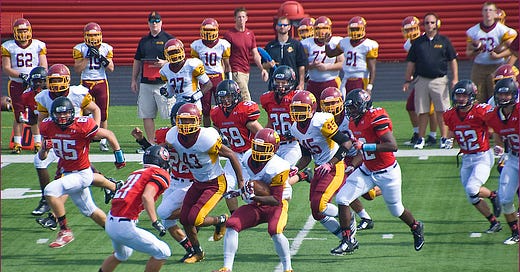Super Bowl Excitement Can't Hide Football's Continuing Decline
SERIES: The Future of Football, Part 3
This is part 3 of my series on the future of football. Part 1 was titled, Before the pandemic, the rise and decline and Part 2 explained why college football on Saturdays and the NFL is on Sundays. Today, in Part 3 I update high school football participation statistics through the 2021-2022 academic year, which have recently been released after two years of no data due to the pandemic.
Football remains an immensely popular sport among high school boys, but participation has been steadily declining for more than a decade. The graph below shows that in fall 2021 about 974,000 boys played football in the US — the lowest since 1997. The data is collected by NFHS.org and there was no data reported for 2019 and 2020 due to the pandemic. High school football participation peaked in 2008 at more than 1.1 million and has fallen steadily since.
The continuing drop into 2021 may be related to the effects of the pandemic, but it also continues a trend that was in place long before the pandemic. There were about 150,000 less boys and girls each participating in sport in 2021-22 compared to 2018-19, indicating an effect of the pandemic. However, the fall in participation is not simply due to an overall decrease in students participating in sport — it represents a declining interest in football specifically. In 2021, only 23% of boys playing a high school sport played football, the lowest percentage since data was first collected in 1969.
More than 350 high schools across the country have dropped football since 2017 (about 2.5% of all schools). The number of players per team has dropped as well, from 75 to 71. The figure below shows change in participation by state over the five years from 2016 to 2021.
Falling participation is occurring across the country, including for the first time across the southeast, which is where football is the most popular. Texas has long been an exception to overall national trends in football participation, and 6 other states saw small increases over the five years.
Here are the top 15 states where football participation has dropped them most since 2017:
Wisconsin -30.9%
Alaska -23.9%
Washington -18.9%
New York -17.5%
New Mexico -16.6%
Illinois -16.3%
New Hampshire -15.1%
Michigan -15.1%
Nevada -14.5%
Arkansas -14.3%
Oregon -13.8%
Florida -12.9%
California -12.8%
Hawaii -12.7%
New Jersey -12.3%
These are not small numbers. The large falloff in the upper Midwest is surprising, as is the decreases in Florida and across the southeast — all tradition football regions.
There remain almost a million boys playing football, or an average of ~240,000 per class (assuming 4 years in high school). Across NCAA divisions there are more than 70,000 men who play football, or about 14,000 per class (assuming 5 years). In the highest NCAA division (called FBS) there are more than 10,000 players, or about 2,000 per class. So there remains a very large pool of high school players from which to populate college teams, especially the top teams, which need only about 1% of graduating high school senior football players to fill out their incoming rosters.
The ground underneath the “king of sports” is changing. If current trends continue, it won’t be too long before football in America will start to look very different, and not just in high schools but eventually in colleges as well.
But even if high school participation rates continue to drop, the NFL won’t be changing any time soon, as there are so few players at that level. Enjoy the game!







Good data analysis.
Very interesting indeed.
Thank you.